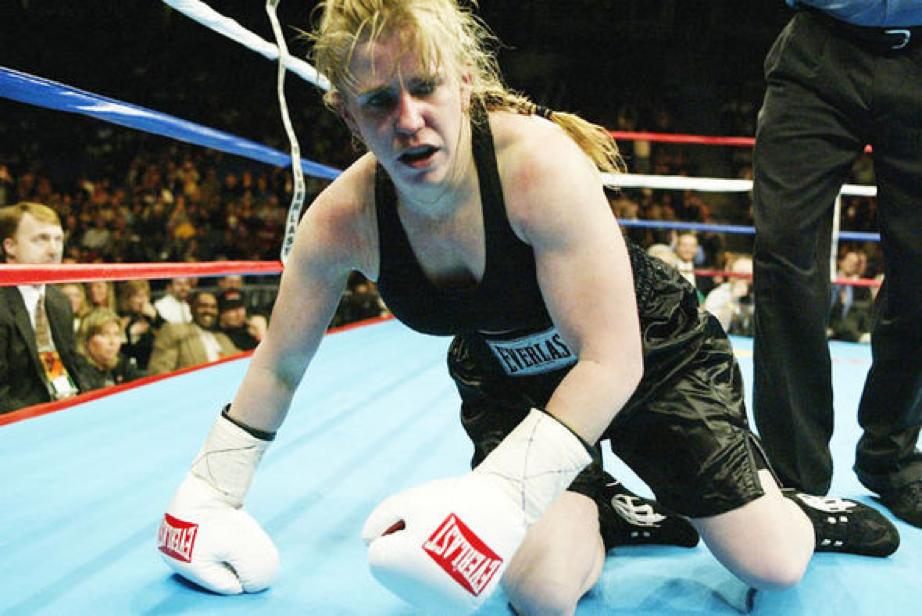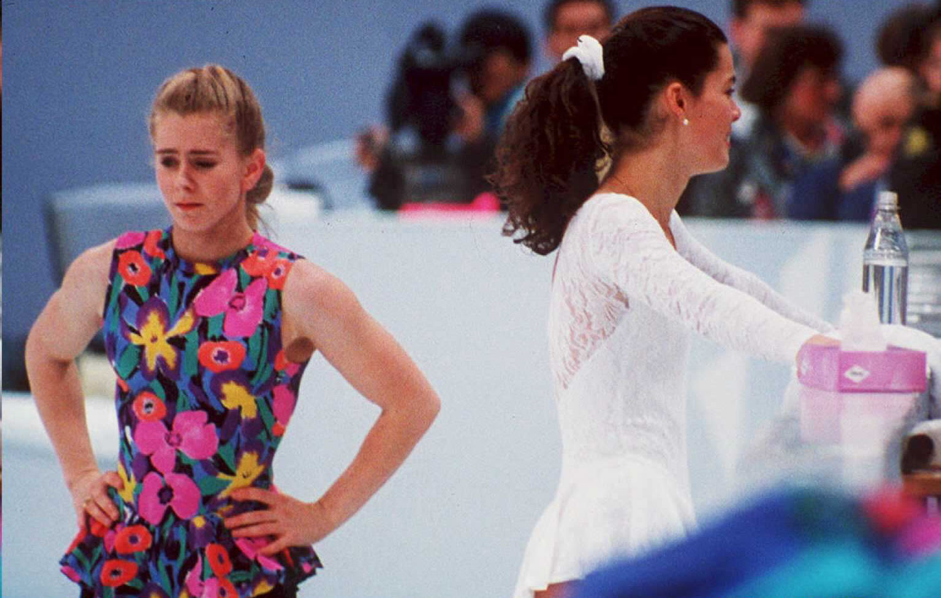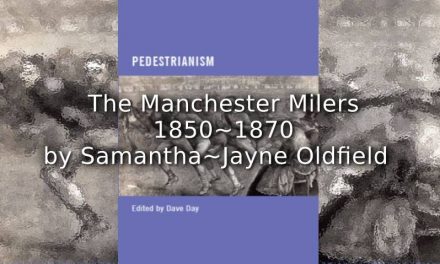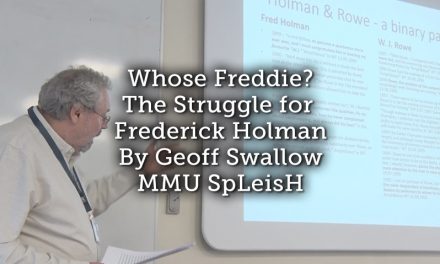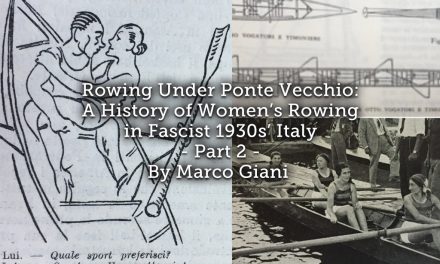Symbolic violence is the coercion which is set up only through the consent that the dominated cannot fail to give the dominator (and therefore to the domination) when their understanding of the situation and relation can only use instruments of knowledge that they have in common with the dominator. (Bourdieu, 2000)
In a country, like the USA that believes in equality for all, the depiction in ‘I, Tonya’ is one that smashes on the floor like a chandelier in ‘Only Fools and Horses’.
Recriminations fly between the main protagonists, and the truth is argued over between Tonya Harding, her ex-husband, her mother and her deceased bodyguard, amongst others. As a piece of comedic drama, this film hits the heights, but like great comedy, the film is delivered with either a punch to the nose, a slap with an open hand to the face and a uppercut to Tonya’s jaw (see image above, on which the film concludes with Margot Robbie being punched). You feel those slaps. It wakes you up to the domestic violence Harding all too frequently suffered. Anyway, this article is a short look at the film, the idea of the American dream and Pierre Bourdieu and cultural capital within the context of the story.
For some of us, this was one of the major sporting stories of the 1990’s, but for some it’s ‘who is Tonya Harding?’ Tonya Harding was a American Olympic ice skater of the late 1980’s to 1990s. She was famous for her ex-husband and bodyguard getting friends to knee-cap her nearest US rival, Nancy Kerrigan, prior to the 1994 Winter Olympics.
In many ways this is a simplification of the story and certainly not the be-all of the story (or this article). The film also looks at representation of Tonya Harding, who says of herself that she is ‘white trash’, and is portrayed as such by everyone in the film – being worthless, devalued and discarded not only by the snobbery of the ice skating community but also by her own family, especially her mother and husband who stab her with a knife and shoot at her respectively to underline they are the ones who hold power over her.
Within the context of the film, Tonya Harding is often spurned. The film does not shy from her ‘white trash’ roots. Tonya wants a fur coat in order to fit in with her ice skating peers, she goes shooting rabbits with her dad to make her own fur coat. Although derided by her peers young Tonya’s answer is simple – a middle finger salute.
The problem with Tonya is, as Pierre Bourdieu’s book ‘Distinction: A Social Critique of the Judgement of Taste’ (1984) points out :-
One would have to take account of the representation which, in terms of their specific schemes of perception and appreciation, the different classes have of the costs (economic, cultural and ‘physical’).
The irony is that Tonya Harding competes in a sport with a class bias, as perceived by the authority figures within the film. Bourdieu (1984) has noted about taste:-
Thus, the opposition between the heavy and the light, which, in a number of its uses, especially scholastic ones, serves to distinguish popular or petit-bourgeois tastes from bourgeois tastes, can be used by theatre criticism aimed at the dominant fraction of the dominant class to express the relationship between ‘Intellectual’ theatre [or Sport], which is condemned for its ‘laborious’ pretensions and ‘oppressive’ didacticism, and ‘bourgeois’ theatre, which is praised for its tact and its art of skimming over surfaces.
Tonya, in taking part in a sport predominantly run by the bourgeoisie, is often derided or criticised by such people. On two occasions she confronts the judges on why she is not given higher marks. The second time she is told by one judge, Bob Rawlinson that ‘you need to see a wholesome American family’. To which she responds ‘I don’t have a wholesome America family.’ Tonya, on the other occasion questions the judge after getting a score of 4.8 – ‘How do I get a fair shot here?’ The judge replied ‘We also judge on presentation.’ To which she responds ‘Suck my dick’. Her lack of ‘presentation’ is often seen in her dance style and certainly her contemporary use of skating attire in comparison to the American darling of Nancy Kerrigan as depicted in the image below.
Cynthia Baugman (1995) edited book ‘Women on Ice : Feminist Essays on Tonya Harding Nancy Kerrigan Spectacle’ underlined the point that Nancy’s looks were more important than her skating and especially compared to that of Tonya Harding. While Sam Stoloff’s ‘Bodily figuration of social class’ has indicated that Ice Skating ‘has served to rationalise hierarchy, through its reinforcement of ideas of the career open talent, and of natural aristocracy.’ Tonya is certainly not aristocracy and is always seen to be fighting a losing battle both within the film and America’s mediated society.
The irony though is that while Nancy certainly has the bourgeois ‘class’ of looks, style and grace cited by Bourdieu, Tonya has one important thing that Kerrigan does not have. Tonya can execute perhaps one of the most difficult feats in ice skating – the triple axel:-
The Triple axel is defined thus:-
The Axel is the only forward-facing jump in figure skating and is the most difficult of the six jumps being done today.
It was named for its creator, Axel Paulson, who invented the jump in 1882. For a single Axel, the way Paulson did it, a skater takes off from a forward outside edge and rotates one-and-a-half times in the air before landing on the back outside edge on the opposite foot from which they took off. (Lutz, 2017)
E.M Swift (1991) said of her US figure skating championship win :-
After all the hankies were wrung out and all the teardrops had fallen, the U.S. Figure Skating Championships last week in Minneapolis belonged to a 20-year-old dynamo from Portland, Ore., named Tonya Harding. In one energized four-minute free skating program, Harding leapt from nowhere into history as she became the first American woman to land a triple Axel in competition.
But, within the gender politics of sport this is frowned upon – within the film her mother points out it’s no mean feat for a ‘large girl’ like Tonya to be able to do it, underlining her lack of ‘femininity’. Her mother also says of Tonya in the film ‘you skated like a graceless bull-dyke, I was embarrassed for you.’ Feder underlines a similar point in his article ‘’A radiant smile from the lovely Lady : Overdetermined femininity in ‘ladies’ figure skating” (Baugman, 1995):-
[Paul] Boitano [former ice skating olympian] himself said of Tonya Harding, ‘she jumps like a male skater’……When physical capabilities no longer distinguish men and women, femininity is overdetermined to keep female athletes from being labeled masculine or lesbian.
Paradoxically, Tonya is often portrayed as a ‘masculine’ construct, her profanity, her ability to do the triple axel (previously only within the male compass) and to be implicated in the ‘capping’ of Nancy Kerrigan – all things no ‘lady’ would do. However, Harding does not lack femininity (a social construct), she only lacks anyone giving her a chance, for example, when her skate bootstraps break at Lillehammer and she cries and begs the judges to allow her to change her boots:-
http://players.brightcove.net/219646971/default_default/index.html?videoId=5620218526001
Does she get any sentiment from America for showing a her vulnerable side? No. Rather she’s mocked on the David Letterman show.
As Tonya says in the film:-
America. They want someone to love, but they want someone to hate, and the haters always say. “Tonya, tell the truth!” There’s no such thing as truth. I mean it’s bullshit!
In conclusion, I, Tonya is a tour de force of a victim of her class. A woman who tries to live her dream, a woman beaten by her mother and husband. A woman banned from the sport she loved, as she was a ‘natural’. In the end, the infamy of the Nancy Kerrigan case meant she had to become a boxer to earn a living. The concluding image of her hitting the canvas with a bloodied mouth, Tonya looks the camera straight in the eye and gets up. The power of I, Tonya is in her indelible power not to be beaten, as she says ‘My entire life I’ve been told I wouldn’t amount to anything. Well, you know what, maybe I would.’
Article © Les Crang
References
- Baughman, C. (1995). Women on Ice, Feminist Essays on the Tonya Harding/Nancy Kerrigan Spectacle. 1st ed. New York: Routledge.
- Bourdieu, P. (2000). Pascalian meditations. 1st ed. Cambridge: Polity.
- Crosson, S. (2013). Sport and Film (Frontiers of Sport). 1st ed. New York: Routledge.
- Giulianotti, R. (2005). Sport: A Critical Sociology. 1st ed. Cambridge: Polity.
- Giulianotti, R. (2006). Sport and modern social theorists. 1st ed. New York: Palgrave Macmillan.
- Ingle, Z. and Sutera, D. (2013). Identity and Myth in Sports Documentaries: Critical Essays. 1st ed. Lanham, MD: Scarecrow Press, Inc.
- Lutz, R. (2017). Figure skating triple Axel: What it is and why it’s important. [online] NBC Olympics. Available at: http://www.nbcolympics.com/news/figure-skatings-triple-axel-what-it-and-why-its-important [Accessed 19 Jan. 2018].
- Swift, E. (1991). Triple Threat. [online] SI.com. Available at: https://www.si.com/vault/1991/02/25/123688/triple-threat-tonya-harding-won-a-us-figures-title-with-an-unprecedented-triple-axel [Accessed 21 Jan. 2018].

![I, Tonya, Cultural Capital and the American Dream [Spoiler Alert]](https://www.playingpasts.co.uk/wp-content/uploads/2018/02/tonyabanner.jpg)
